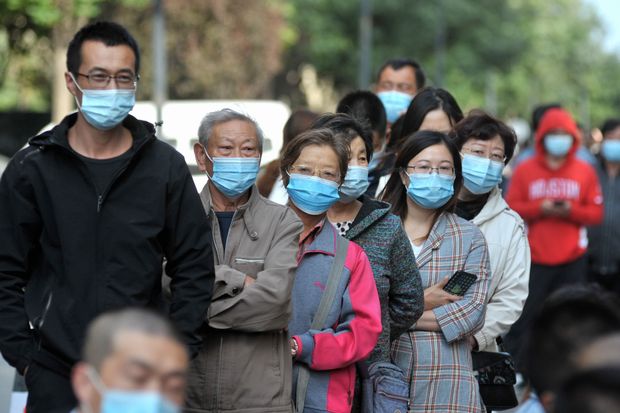
China tested 9 million residents of Qingdao for COVID-19 in just five days.
Agence France-Presse/Getty Images
NEW HAVEN, Conn. (Project Syndicate)—Just as China led the world in economic recovery in the aftermath of the global financial crisis of 2008, it is playing a similar role today. Its post-COVID rebound is gathering momentum amid a developed world that remains on shaky ground.
Unfortunately, this is a bitter pill for many to swallow—especially in the United States, where demonization of China has reached epic proportions.
“ China’s approach today is similar: first, insulate its citizens from a virulent pathogenic contagion with draconian public-health measures aimed at containing and mitigating the spread of the disease, and then—and only then—make judicious use of monetary and fiscal policy to reinforce the post-lockdown snapback. ”
The two crises are, of course, different.
Wall Street was ground zero for the 2008 crisis, while the COVID-19 pandemic was spawned in the wet markets of Wuhan. But in both cases, China’s crisis-response strategy was far more effective than that deployed by the U.S. In the five years following the onset of the 2008 crisis, annual real gross domestic product growth in China averaged 8.6% (on a purchasing power parity basis). While that was slower than the blistering (and unsustainable) 11.6% average pace of the five previous years, it was four times the U.S. economy’s anemic 2.1% average annual growth over the postcrisis 2010-14 period.
China’s pandemic response hints at a comparable outcome in the years ahead. The GDP report for the third quarter of 2020 suggests a rapid return to the pre-COVID trend. The 4.9% year-on-year figure for real GDP growth does not convey a full sense of the self-sustaining recovery that is now emerging in China.
Measuring economic growth on a sequential quarterly basis and converting those comparisons to annual rates—the preferred construct of U.S. statisticians and policy makers—provides a much cleaner sense of real-time shifts in the underlying momentum of any economy. On that basis, China’s real GDP rose at an 11% sequential annual rate in the third quarter, following a 55% post-lockdown surge in the second quarter.
The comparison with the U.S. is noteworthy. Both economies experienced comparable contractions during their respective lockdowns, which came one quarter later for the U.S. China’s 33.8% sequential (annualized) plunge in the first quarter was almost identical to the 31.2% U.S. contraction in the second quarter.
Based on incoming high-frequency (monthly) data, the so-called GDPNow estimate of the Atlanta Federal Reserve puts third-quarter sequential real GDP growth in the U.S. at around 35%. While that is a welcome and marked turnaround from the record decline during the lockdown, it is about 20 percentage points short of China’s post-lockdown rebound and still leaves the U.S. economy about 3% below its peak of late 2019.
On MarketWatch now: Record 30% surge in GDP is coming, but it may be too late to help President Trump
Post-lockdown rebounds are not the real story, however. They are akin to the snapback of a stretched rubber band—or in statistical terms, the arithmetical result of restarting an economy that has just been subjected to an unprecedented sudden stop. The true test comes after the snapback, and that’s where China’s strategy has its greatest advantage.
China’s response to COVID-19 borrowed a page from its playbook in 2008, when it ringfenced its financial markets from the toxic fallout of the subprime crisis. The objective back then was crystal clear from the start: address the source of the shock, itself, rather than the collateral damage the shock caused. The CN¥4 trillion ($596.4 billion) fiscal stimulus of 2008-09 worked only because China had taken strong actions to insulate its markets from a virulent financial contagion.
China’s approach today is similar: first, insulate its citizens from a virulent pathogenic contagion with draconian public-health measures aimed at containing and mitigating the spread of the disease, and then—and only then—make judicious use of monetary and fiscal policy to reinforce the post-lockdown snapback.
This is very different from the approach taken in the U.S., where the post-lockdown debate is more about using monetary and fiscal policies as front-line instruments of economic liberation, rather than relying on disciplined public-health measures aimed at virus containment.
This underscores the sharp contrast between China’s COVID-first strategy and the America-first approach of President Donald Trump’s administration.
In China, unlike the U.S., there is no political and public resistance to masks, social distancing, and aggressive testing as requisite norms of the COVID-19 era. Meanwhile, the U.S. is in the midst of its third serious wave of infection while China continues to exercise prompt and effective control over new outbreaks.
Earlier this autumn, for example, some 9 million citizens in Qingdao were tested in just five days after a relatively small outbreak affecting fewer than 20 residents. By contrast, Trump wears his own experience with COVID-19 infection as some perverse badge of courage, rather than as a warning of what may lie ahead.
Surging coronavirus colors White House race in closing days
In this context, China’s impressive GDP results in the third quarter stand in even sharper contrast with the precarious post-lockdown state of the U.S. economy. Ongoing distress in the U.S. labor market—unemployment insurance claims remained above 800,000 on a four-week moving average through mid-October, and the 7.9% national unemployment rate in September was still more than double its pre-pandemic 3.5% level—leaves America’s consumer-led economy highly vulnerable to a setback. The confluence of a new COVID-19 wave with the on-again, off-again political debate over another fiscal relief package has effectively neutralized the animal spirits that have long powered economic recovery in the U.S.
Breaking news: Dow falls more than 500 points as stocks open sharply lower on COVID case rise
While China’s 11.2% sequential (annualized) growth in the third quarter of this year builds effectively on its post-lockdown snapback, some lingering signs of weakness are evident in several key segments of consumer services—namely travel, leisure, and entertainment. Human nature is the same everywhere, with fear and caution enduring, even in countries where aggressive containment measures are working.
For those unwilling to focus on containment, such as the U.S., the long shadow of COVID-19 speaks volumes to the ever-present perils of a double-dip recession. That is exactly what has happened in the aftermath of eight of the last 11 U.S. recessions. The contrast with China’s self-sustaining recovery couldn’t be more striking.
This article was published with permission of Project Syndicate—China Leads Again
Stephen S. Roach, a faculty member at Yale University and former chairman of Morgan Stanley Asia, is the author of “Unbalanced: The Codependency of America and China. “
More viewpoints from Project Syndicate:
Why Wall Street is doing great while Main Street is still closed
The U.S. is heading for a constitutional crisis—even if Biden wins
Trump has corrupted American free enterprise with his own brand of crony capitalism





